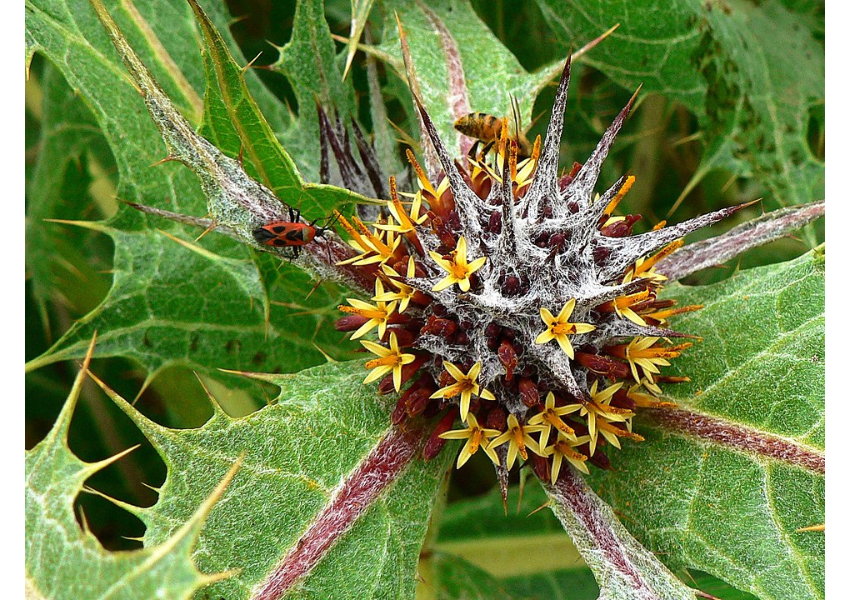Uncovering the Roots of Israel’s Wild-Plant Legacy
Delve into Israel's flavorful past as wild plants find new life on modern plates
By Janna Gur
Published Jan 19, 2023

Thumble Thistle
COURTESY MATT KNIGHT (WIKIPEDIA)
Vegetables are the backbone of the Israeli food culture, but in ancient times, they were only a marginal part of the local diet. Tomatoes, peppers, and eggplants, kings of Levantine cuisine, were not even around. The vegetables that were part of the Biblical vegetable basket (radishes, cabbage, squash, onions, fennel) were actually quite rare. With their short growing cycle, vegetables need constant irrigation, a costly affair in those days. Simple folks usually made do with “field vegetables” – yerakot hasadeh. As they were called in the Hebrew Scriptures – wild edible plants. Most grow in abundance during the rainy season, but some are available year-long, especially near streams or brooks.
Foraging and cooking wild plants remain part of the Palestinian food culture. People still go out into the fields to pick mustard greens, wild chicory, wild asparagus, wild spinach, fresh za’atar, mallows, the list goes on.
One of the most coveted wild edible plants is gundelia, or tumble thistle, best known in Israel by its Arabic name akub. Come summer, it turns into a spiky wheel-like thorn, but during the rainy season, its stems and flower buds are tender and juicy, their taste a cross between asparagus and artichoke.
In Tiberias, where Jews and Arabs have been living in close proximity and a relatively harmonious co-existence for centuries, a unique cuisine has evolved. Part Levantine, part Sephardic, it even has some Ashkenazi influences. One of the Tiberian delicacies, the star of the Passover table, are panjas – lamb patties wrapped around a stem of akub.

Wild mallows (houbeza) on the shores of the Sea of Galilee
COURTESY OF THE GALILEE TABLE
Akub might be the most sought-after wild-grown plant, but mallows, known by their Arabic name houbeza, are the most ubiquitous. Come winter, it grows absolutely everywhere: in the fields, near water pipes, in the backyards, and even on sidewalks. When fresh and green, the umbrella-shaped leaves are juicy and delicious, sautéed with garlic and olive oil and dressed with lemon juice. But the dish that made this herb truly famous, even among those who have never tasted it, is houbeza fritters (kzitzot hobeza).
In February 1948, shortly before the Independence War Broke, Arab militias blockaded the main corridor between Jerusalem and Tel Aviv, creating severe shortages in essential supplies. Food was strictly rationed, and Jerusalemites were encouraged to cook with houbeza, which luckily was still in season in early spring. Recipes for houbeza fritters were even broadcasted on local radio.
Dishes made from foraged plants are very popular in contemporary Palestinian/Levantine restaurants. Some plants are held in such high esteem, that they are now grown commercially or picked in season and frozen, so they can be used year-round. Recently, Jewish Israeli chefs have joined the trend. Dishes made with wild edible plants grace menus of some of the most prestigious restaurants. Some even employ in-house foragers or go out on foraging exhibitions.
As Israel’s culinary landscape continues to evolve, the resurgence of wild plants not only reconnects modern palates with ancient traditions but also fosters a deeper appreciation for the diverse flavors rooted in the region’s rich history.
Janna Gur is a Tel Aviv-based cookbook author, journalist, speaker, and culinary expert.
Reflections
It's organic!
Have you ever been on a foraging expedition? If not, is this something you would like to try? Is this something that feels possible in the area in which you live?
For culinary connoisseurs:
Have you tasted any of the plants mentioned above?
Want more?
Get curated JewishArts.org content in your inbox


